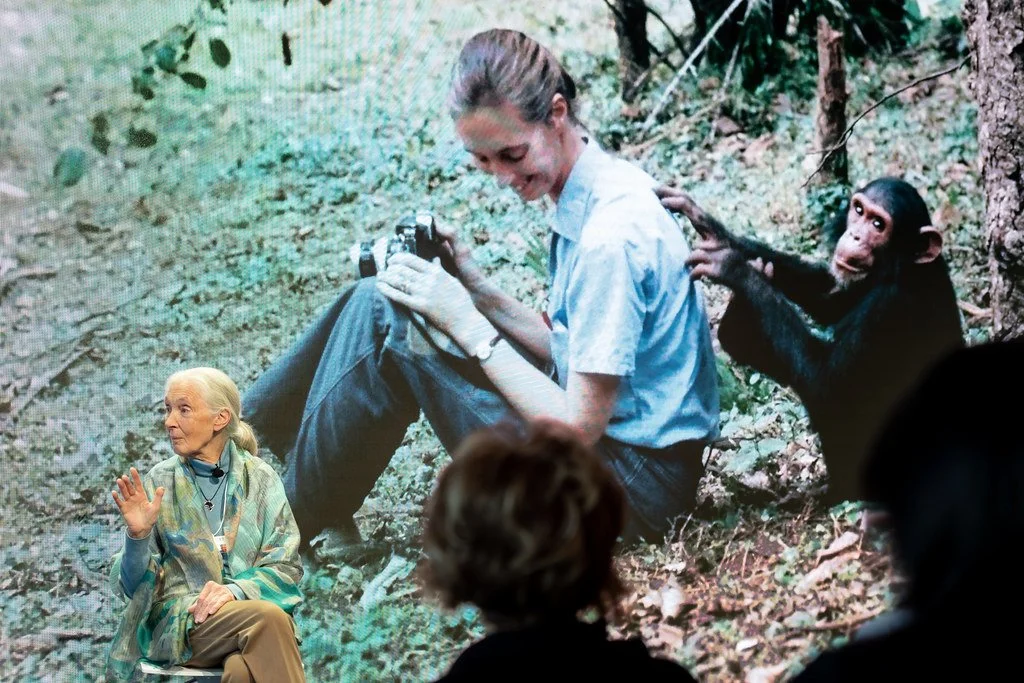Remembering Jane Goodall, the Woman Who Changed How the World Sees Animals
Jane Goodall's life and legacy has been reimagined through different forms of artwork and media. “Close Encounters with Jane Goodall and Skye Meaker” by World Economic Forum, CC BY-NC-SA 2.0 via Flickr
Jane Goodall, the primatologist and humanitarian whose groundbreaking research on chimpanzees transformed science and reshaped the world’s relationship with animals, died on Oct. 1 in California. She was 91.
While she was best known for her fieldwork in Tanzania’s Gombe Stream National Park, Goodall’s legacy extended far beyond the forest. Over six decades, she became one of the most influential figures in conservation and culture.
When Goodall arrived in Gombe in 1960 with a pair of binoculars and little experience, few expected her to make her mark in the field of primatology like she would. Yet her observation that chimpanzees used tools, which had long been considered a uniquely human trait, forced scientists to rethink the boundary between humans and other animals.
In the decades that followed, Goodall’s role evolved. She founded the Jane Goodall Institute in 1977 to support wildlife research and conservation, and in 1991 launched Roots & Shoots, a youth program aimed at empowering young people to engage in environmental activism.
“Young people get it. Once they’re exposed and understand, they take action. They do all sorts of things. It’s very moving,” Goodall said in an interview with Imagine5. “We bring them together virtually, to help swap ideas and they’re learning that much more important than the colour of your skin, your language, your culture, or your religion, is the fact that we’re all human beings.”
But it was her unique ability to communicate that made her a global figure. Through countless lectures, books and interviews, Goodall brought the animal world into public consciousness.
She could move from speaking at the United Nations to talking with children about the lives of chimpanzees, always returning to her central message: that every individual has a role to play in the care of the planet.
“Intellect without wisdom, or intellect without the heart – it comes back to the same thing. We’ve brought climate change, loss of biodiversity and this pandemic on ourselves by disrespecting nature and animals. It’s terribly important that we really realize that we are so connected with the natural world and it’s desperately important to protect it,” Goodall told Imagine5.
Goodall’s image as soft-spoken and often photographed among the chimps she studied became a symbol of gentleness and care. She inspired a generation of environmentalists, writers and filmmakers who saw in her a model for combining science with compassion.
Documentaries like “Jane” (2017) and “The Hope” (2020) helped frame her story for new audiences. Artists have reimagined her in sculptures and street murals. Her books, including “Reason for Hope” and “The Book of Hope: A Survival Guide for Trying Times,” connected Goodall’s personal story with environmental ethics in a way few scientists had done before.
Following her death, Goodall’s work has found renewed resonance among young activists today. Her message that even small actions matter has become essential for youth climate movements and environmental educators worldwide.
Even into her nineties, Goodall remained active, traveling the world to speak about conservation, climate change and our relationship with animals. Her passing marks the end of an era, but also the beginning of a new chapter in how her story is told.
Goodall’s legacy endures not just in scientific papers or conservation programs, but in the way people recognize their place in nature and that their actions matter. She taught that to understand animals is to understand ourselves, and that empathy is the foundation of science and her vision for a better world.
“It would be a world where everybody lived in a way that was in harmony with nature and with each other. It would be a world without hatred and bitterness. It would be a world where love and compassion are the most important elements and it would be a world where everybody understood that animals have feelings just like us. And we’re getting there,” Goodall said.
Goodall’s life serves as a guide: humans and animals are more alike than we once thought, and that hope is still worth protecting.
